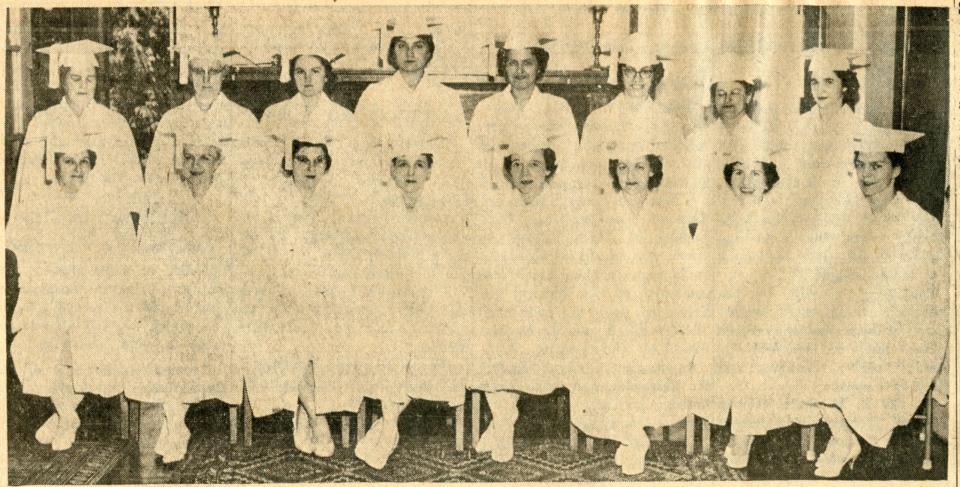Historically Speaking: The Exeter school of Practical Nursing
Dottie Milbury recently called the Exeter Historical Society to suggest we highlight the Exeter School of Practical Nursing. She has a personal connection – her mother, Frances Buxton, was on the faculty.
A highly accomplished professional, Buxton brought her training from Danvers State Hospital School of Nursing, Boston City Hospital School of Nursing and Simmons College, where she received a BS degree. The program was not the same as the Exeter Hospital Nurses Training School that had run from 1909 – 1935. That school prepared students for a career as a registered nurse. Practical nursing had different training with different certifications.

Until the 1890s, most nurses were minimally trained and there were few standards. Hospital-based programs were the norm. The American Nurses Association, which was organized at that time, called for uniform credentialing and separate training for different levels of nursing care. World War I and World War II hastened the need for trained nursing. Registered nurses required several years of education, but there was a demand for nursing for more practical care. In 1941, the National Association for Practical Nursing Education and Service was established and by 1945 it became the primary accrediting agency for practical nurse training programs. As the second world war ended, it might seem like the nursing shortage at home would ease up – what with all the nurses coming home. But, having put their lives on hold for years, most of the returning nurses got married and many health facilities required them to leave if they were married or had children. The nursing shortage grew worse.
By 1955, the N.H. legislature began looking into the problem. Four bills were proposed to encourage recruitment and education. James Rathbone reported for the Exeter News-Letter, “Of special importance were two of the bills which had to do with the establishing of nurse training programs in connection with state-operated institutions of learning and other accredited nursing schools as an aid to students looking forward to a licensed practical or registered nurse’s career.” The plan was to move training from hospital-based to state-funded programs. This would include state funding and available scholarship programs. Hospital-based programs had traditionally provided room, board and training but required students to work 12–24 hours shifts at a mere stipend. Rathbone continued that, “the idea was received not without opposition, however, from other sources, and a strong anesthetic may need to be administered before the green light is given by the appropriation committee.”
In early 1960, it was announced that, “a school of practical nursing under the administration of the New Hampshire Technical Institute of Portsmouth… is to be opened at Exeter Hospital this spring.” Exeter Hospital was chosen as the training site because it still had the infrastructure from the nurse’s training school in place. The former nurse’s home, still on-site, was renovated to include classroom space. Admission was open, “following preliminary examination, both men and women between the ages of 18 and 50 years will be accepted by the school following evaluation of their past educational background and personal interview.” The fledgling program was part of a Channel 11, WENH-TV program that December called, “Nursing.” It was advertised as, “designed to provide full information to parents and students on practical nursing as a career.”
One thing was certain, nurses were no longer expected to be single women. The field was opened to men to accommodate servicemen who’d served as medics. Married women and mothers were no longer rejected. Indeed, when announcing her hiring, she was “Mrs. Frances Buxton” hired as a nursing instructor. Older students were welcomed – many with private nursing experience under their belts.
The program affiliated with Wentworth-Douglas Hospital (then called Wentworth-Dover) in 1962, provided students with two healthcare systems to study. Training took one year, after which students tested for their Licensed Practical Nurse credentials. LPNs quickly took over many of the hands-on duties in hospital wards and the growing number of nursing and rehabilitation facilities. Able to do dressing changes, patient care, and most importantly medication administration, LPNs were (and still are) valuable members of medical care teams.
In 1965, the Exeter Hospital coordinator of the program, Margaret Curran, announced that the program would no longer have the name “Exeter School of Practical Nursing” as it was moving most of the classroom work to the New Hampshire Vocational Institute in Portsmouth. There would no longer be housing available at Exeter, but the increase in classroom space would encourage more enrollment. The program continued as the “New Hampshire Vocational Institute Practical Nursing Program.” Frances Buxton continued as an instructor retiring in 1972.
Barbara Rimkunas is the curator of the Exeter Historical Society. Many thanks to Dottie Milbury for this history! Support the Exeter Historical Society by becoming a member. Join online at www.exeterhistory.org.
This article originally appeared on Portsmouth Herald: Historically Speaking: The Exeter school of practical nursing

